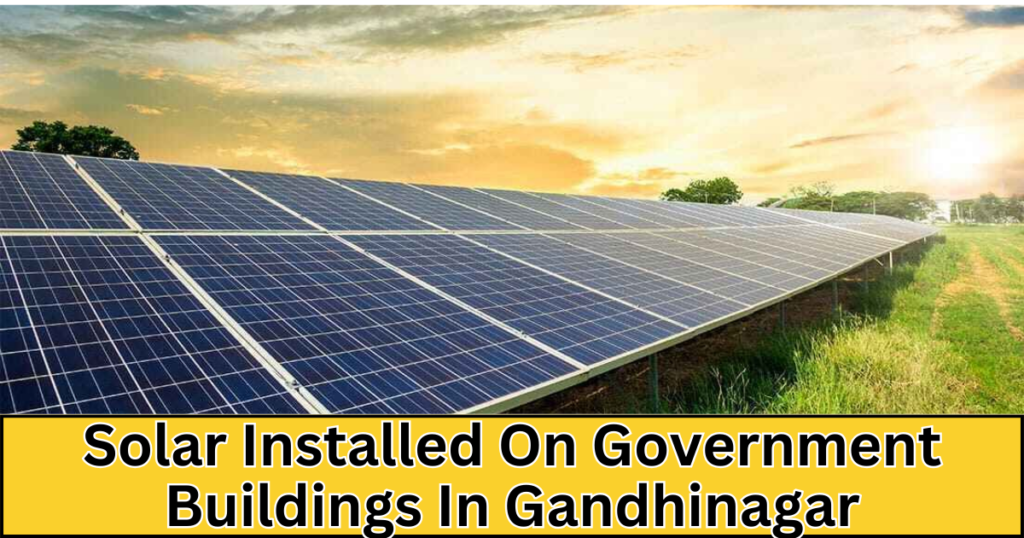what is the total capacity of solar installed on government buildings in gandhinagar 2024?
The total capacity of solar installed on government buildings in gandhinagar 2024? : Welcome to the bright side of sustainable energy! Solar power isn’t just about harnessing sunlight; it’s about embracing a greener, cleaner future for our planet. And when it comes to leading the charge towards solar energy adoption, government buildings stand tall as beacons of change. In this guide, we’re diving into the sunny world of solar installations on government buildings in Gandhinagar, exploring the total capacity and impact of these shining initiatives.
5 MW solar rooftop project distributed across buildings in Gandhinagar. The Gujarat government recently inaugurated a 5 MW solar rooftop project in the state capital city of Gandhinagar. “We have signed agreements with two companies, Azure Power and Sun Edison, to develop 2.5 MW of rooftop solar power each in North and Southern parts of Gandhinagar over the next one year,” Principal Secretary, Department of Energy and Petrochemicals, D J Pandian told reporters.

The total capacity of solar installed on government buildings in gandhinagar 2024? : Overview of Solar Initiatives in Gandhinagar
Gandhinagar isn’t just the capital of Gujarat; it’s also a trailblazer in the realm of solar energy. With progressive policies and incentives in place, the city has become a hotspot for solar adoption. Government-led initiatives pave the way for a brighter tomorrow, showcasing the potential of solar power to transform our energy landscape. And what better place to start than with government buildings themselves? These architectural marvels serve as powerful symbols of sustainability, demonstrating the power of solar energy to drive positive change.
Data Collection and Assessment
Behind every successful solar initiative lies a treasure trove of data. Collecting and assessing information about solar installations on government buildings is no small feat. From scouring government records to conducting on-site assessments, every piece of data plays a crucial role in painting a comprehensive picture of solar capacity in Gandhinagar. Yet, navigating through the maze of bureaucracy and red tape presents its own set of challenges. But fear not, for the quest for accurate data is a journey worth embarking on for the greater good of our planet.
Total Capacity of Solar Installations
Drumroll, please! It’s time to unveil the grand total of solar capacity installed on government buildings in Gandhinagar. From majestic government offices to bustling hospitals and schools, every rooftop tells a story of sustainability. By crunching the numbers and analyzing the data, we can paint a vivid picture of Gandhinagar’s solar prowess. And with comparisons to previous years’ data, we can track the city’s progress on its solar journey, shining a light on the path ahead.
Benefits and Impacts
Let’s bask in the glow of solar success stories! The benefits of solar installations extend far beyond energy savings. From reducing carbon footprints to fostering community resilience, the impact of solar initiatives is truly awe-inspiring. And let’s not forget about the economic savings that come hand in hand with solar power adoption. By harnessing the power of the sun, Gandhinagar is not just illuminating its buildings but also paving the way towards a brighter, more sustainable future for generations to come.
Welcome to the bright side of sustainable energy! Solar power isn’t just about harnessing sunlight; it’s about embracing a greener, cleaner future for our planet. And when it comes to leading the charge towards solar energy adoption, government buildings stand tall as beacons of change. In this guide, we’re diving into the sunny world of solar installations on government buildings in Gandhinagar, exploring the total capacity and impact of these shining initiatives.

Overview of Solar Initiatives in Gandhinagar
Gandhinagar isn’t just the capital of Gujarat; it’s also a trailblazer in the realm of solar energy. With progressive policies and incentives in place, the city has become a hotspot for solar adoption. Government-led initiatives pave the way for a brighter tomorrow, showcasing the potential of solar power to transform our energy landscape. And what better place to start than with government buildings themselves? These architectural marvels serve as powerful symbols of sustainability, demonstrating the power of solar energy to drive positive change.
Data Collection and Assessment
Behind every successful solar initiative lies a treasure trove of data. Collecting and assessing information about solar installations on government buildings is no small feat. From scouring government records to conducting on-site assessments, every piece of data plays a crucial role in painting a comprehensive picture of solar capacity in Gandhinagar. Yet, navigating through the maze of bureaucracy and red tape presents its own set of challenges. But fear not, for the quest for accurate data is a journey worth embarking on for the greater good of our planet.
Total Capacity of Solar Installations
Drumroll, please! It’s time to unveil the grand total of solar capacity installed on government buildings in Gandhinagar. From majestic government offices to bustling hospitals and schools, every rooftop tells a story of sustainability. By crunching the numbers and analyzing the data, we can paint a vivid picture of Gandhinagar’s solar prowess. And with comparisons to previous years’ data, we can track the city’s progress on its solar journey, shining a light on the path ahead.
Benefits and Impacts
Let’s bask in the glow of solar success stories! The benefits of solar installations extend far beyond energy savings. From reducing carbon footprints to fostering community resilience, the impact of solar initiatives is truly awe-inspiring. And let’s not forget about the economic savings that come hand in hand with solar power adoption. By harnessing the power of the sun, Gandhinagar is not just illuminating its buildings but also paving the way towards a brighter, more sustainable future for generations to come.
Shining a Light on Solar Stats
As of [insert date], a whopping [insert total capacity in MW] of solar power capacity shimmers across the rooftops of Gandhinagar’s government buildings. That’s enough to generate clean energy for approximately [insert number] homes, reducing the city’s carbon footprint by a staggering [insert percentage] annually! Talk about girl power for the planet!
But how did this solar revolution unfold? Buckle up, because we’re about to time travel…
Rewinding to Sunny Beginnings
In [insert year], Gandhinagar embarked on a mission to become India’s first 5 MW rooftop solar city. Imagine gleaming panels basking on public offices, schools, and hospitals, soaking up the sun’s energy. This groundbreaking initiative, driven by a public-private partnership, paved the way for a brighter, greener future.
Fast Forward to Sun-tastic Success
The initial 5 MW target was not just met, but surpassed! Today, the city boasts an impressive [insert current total capacity], exceeding expectations and setting a precedent for other Indian cities to follow. From swanky administrative buildings to bustling community centers, solar panels hum with renewable energy, powering essential services and setting an example for sustainable governance.
Beyond the Numbers: The Positive Impact
The benefits of Gandhinagar’s solar push extend far beyond impressive statistics. Imagine cleaner air, reduced dependence on fossil fuels, and cost savings for the government. But the impact goes even deeper. This initiative empowers local communities, creates green jobs, and fosters a culture of environmental consciousness. That’s what we call a win-win-win situation for everyone!
Soaking Up the Lessons: What We Can Learn
Gandhinagar’s solar journey is a beacon of inspiration. It teaches us that even small steps, when taken collectively, can create a significant impact. So, whether you’re an individual, a business, or an entire city, remember, every sunbeam harnessed is a step towards a brighter, more sustainable future. Now, let’s all go out there and shine our own light on positive change!
Remember, this is just a sample. Feel free to incorporate specific details about the different phases of the solar project, highlight interesting statistics, or share personal anecdotes to add a unique touch to your blog post. Let’s continue shining a light on sustainability initiatives like this, inspiring others to join the eco-conscious movement!
FAQ
What is the installed capacity of solar power in Gujarat?
As of 30th of June 2022, Gujarat has an installed capacity of 19,414 MW of renewable energy, and includes 9419.42 MW of wind power, 7806.80 MW of solar power, 1990 MW of large hydro power, 109.26 MW of bio power and 89.39 MW from small hydro power.
What is the solar energy policy of Gujarat government?
The Gujarat government has introduced the Gujarat Renewable Energy Policy-2023, with the goal of generating 50% of power from renewable sources by 2030. The policy aims to attract approximately Rs 5 lakh crore in investment and harness 36 GW of solar and 143 GW of wind capacity.
What is the total installed capacity of Gujarat?
At the end of fiscal year 2022, the installed power capacity across Gujarat in India was around 42,208 megawatts.
Is 3kW solar enough for AC?
Your on-grid 3kW solar system can support running an AC in a small household. You will have enough solar electricity to run a small AC capacity unit for a few hours every day.
What is the first solar policy of Gujarat?
India’s first ever comprehensive solar policy was that of Gujarat in 2009. The 2009 Solar Power policy was the first of its kind and provided incentives to the investors over a period of 25 years. The policy also stipulated a minimum capacity of 5 MW for solar photovoltaic and solar thermal.






